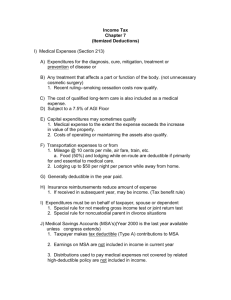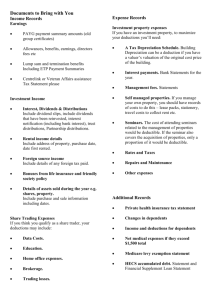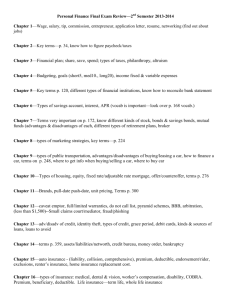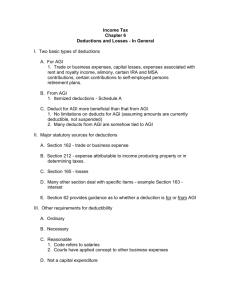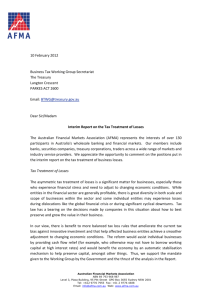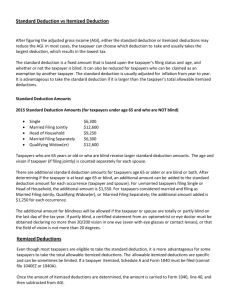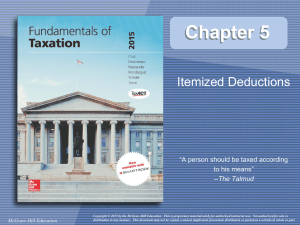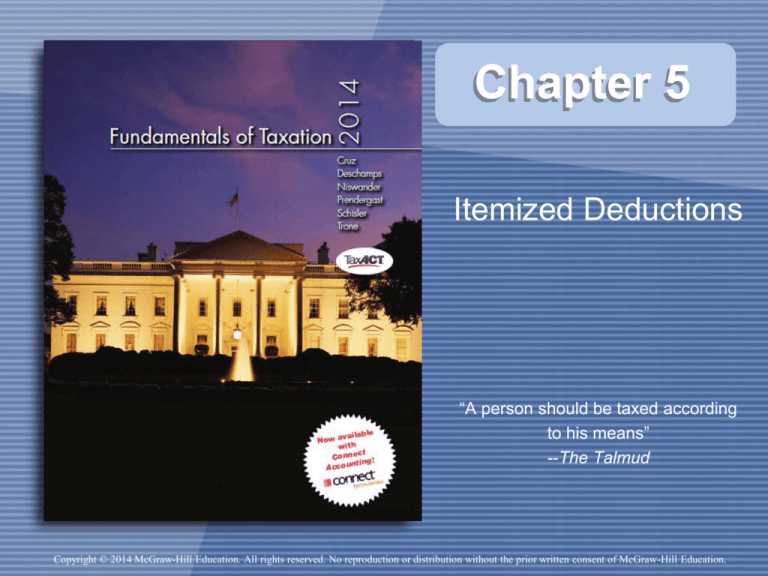
Chapter 5
Itemized Deductions
“A person should be taxed according
to his means”
--The Talmud
Copyright © 2014 McGraw-Hill Education. All rights reserved. No reproduction or distribution without the prior written consent of McGraw-Hill Education.
LO #1 Deductible Medical Expenses
Medical expenses are normally deductible to the
extent that they now exceed 10% of AGI.
– Taxpayers can deduct an itemized deduction for
medical expenses (net of insurance proceeds)
for themselves, their spouse, and dependents.
– The qualifying relationship must exist on the
date expenses are incurred or paid.
– For taxpayers > age 65, the old threshold of
7.5% applies for the years 2013-2016.
5-2
LO #1 Deductible Medical Expenses
Taxpayers may deduct just about all
medical expenses that are doctorprescribed.
Expenses related to the maintenance of
general health are usually not deductible.
A deduction may be claimed only for
medical expenses actually paid during the
taxable year,
regardless of when the care was provided and
regardless of the taxpayer’s method of
accounting.
5-3
LO #1 Deductible Medical Expenses
Medical capital expenditures are deductible
only to the extent that the expenditure
exceeds the increase in FMV of the
property.
• Transportation costs for medical purposes
are deductible and could include such items
as cab, bus, or train fares, as well as
expenses for a personal auto.
• Premiums for Long Term Care insurance
are deductible, but the extent to which is
dependent on the taxpayer’s age.
5-4
LO #2 Deductible State and Local Taxes
There are four major categories of
deductible taxes on individual returns:
personal property taxes, local real estate
taxes, other state and local taxes, and
foreign taxes.
• The taxes that most individual taxpayers
deduct on Schedule A are state and local
income taxes and property taxes on real
estate and personal property.
5-5
LO #2 Deductible State and Local Taxes
• Real estate taxes are deductible in the
calculation of federal taxable income.
– If the tax is paid on personal use real estate,
such as a principal residence, it is an itemized
deduction on Schedule A.
• Personal property taxes paid on personal
use assets, such as the family car, are
deductible on Schedule A.
– For a property tax to be deductible, it must be
based on the value of the property.
– Must be levied on personal property.
– Must be imposed, at a minimum, on an annual
basis
5-6
LO #2 Deductible State and Local Taxes
An individual taxpayer can deduct the
amount of state income taxes actually paid.
Whether through withholding, estimated taxes, or
with the filing of the prior year’s state tax return.
However, if a taxpayer receives a state tax
refund in a following year for taxes deducted
in a prior year, the refund must be included
as taxable income in the year of receipt.
This is the tax benefit rule.
5-7
LO #2 Deductible State and Local Taxes
• The amount of the sales tax deduction
can be determined by calculating
actual sales taxes paid during the year.
– Another way to compute the deduction is to use
the sales tax deduction tables provided by the
IRS in the instructions for Schedule A.
– An additional option is to use the sales tax
deduction calculator on the IRS website
– When using the sales tax tables, taxpayers
determine their sales tax deduction based on
their income and number of exemptions.
5-8
LO #2 Deductible State and Local Taxes
• Foreign taxes paid are deductible.
• Taxpayers have the option of taking a
credit for foreign taxes paid or
deducting the taxes as an itemized
deduction on Schedule A.
– Individual taxpayers are generally better
off utilizing the credit rather than the
deduction because a credit is a dollar-fordollar reduction in taxes.
5-9
LO #3 Deductible Interest
Interest paid on a home acquisition
loan or a home equity loan secured by
a qualified residence is deductible up
to certain limits.
For home acquisition indebtedness, the
interest is deductible only on principal
amounts up to $1,000,000.
For home equity indebtedness, the
interest is deductible only on principal
amounts up to $100,000.
5-10
LO #3 Deductible Interest
• Investment interest is any interest that is paid
or accrued on indebtedness properly
allocable to property held for investment.
– The deduction of investment interest expense is
limited to the net investment income for the year.
– If investment interest expense exceeds net
investment income, the non-deductible excess
expense can be carried forward to future tax
years when net investment income is available.
5-11
LO #4 – Deductible Gifts to Charity
• A charitable contribution deduction
may be claimed as an itemized
deduction on Schedule A.
– The amount of the deduction depends on
the type of donated property and is
subject to AGI limitations.
– In order to be deductible, the donation
must be cash or other property of value.
5-12
LO #4 – Deductible Gifts to Charity
• Depending on the nature of the item
contributed, there are three deduction
limitations for charitable contributions by
individual taxpayers: 50%, 30%, and 20% of
AGI.
– Charitable contributions to public charities are
limited to an overall 50% of AGI.
– The 30% of AGI limitation applies to contributions
of appreciated capital gain property.
– The 20% of AGI limitation is for donations of
capital gain property to a private foundation.
5-13
LO #5 – Deductible Casualty and Theft
Losses
A casualty is defined as an identifiable
event of a sudden, unexpected, or unusual
nature. "Sudden" means the event is not
gradual or progressive.
– In order to claim a deduction, the taxpayer must
own the damaged property.
– The taxpayer’s uninsured loss is calculated as:
Uninsured loss = loss due to casualty or theft
minus insurance recovery.
5-14
LO #5 – Deductible Casualty and Theft
Losses
• In general, the casualty loss is the
lesser of:
– the FMV immediately before the casualty
reduced by the FMV immediately after the
casualty.
– the amount of the adjusted basis for
determining the loss from the sale or
other disposition of the property involved.
5-15
LO #5 – Deductible Casualty and Theft
Losses
• Typically, a taxpayer reports a casualty on
the tax return in the tax year the casualty
took place. However, there are three
instances when casualty losses may be
deducted in different tax years:
– Theft losses.
– Reimbursement by insurance or otherwise
(negligence claim against an individual or
company that caused the loss).
– Disaster area losses.
5-16
LO #5 – Deductible Casualty and Theft
Losses
• The deductible amount is limited.
First, each separate casualty is
reduced by $100. Second, the loss
must be in excess of 10% of AGI.
• Casualty losses are first reported on
Form 4684 and the net loss is carried
to the appropriate form.
5-17
LO #6 – Miscellaneous Itemized
Deductions
• The sum of all the miscellaneous
deductions must exceed 2% of the
taxpayer's AGI before any benefit is
received.
• Unreimbursed employee business
expenses are usually the largest and are
most likely to cause the total miscellaneous
deduction to exceed the 2% floor.
– These expenses are costs incurred by the
taxpayer as a part of his or her employment but
which are not reimbursed by the employer.
5-18
LO #6 – Miscellaneous Itemized
Deductions
• If any travel, transportation, meals, or
entertainment expenses were incurred or
some expenses were reimbursed, then the
taxpayer must complete Form 2106.
• One deduction often missed by taxpayers is
investment advice. If a taxpayer has a large
portfolio of stock or investments, the
advisory cost can be substantial.
5-19
LO #7 – Limitation of Total Itemized
Deductions
• In the case of a "high-income" taxpayer, in the
past a portion of the itemized deductions may
have been forfeited.
– This effectively increased the tax rate of highincome individuals by denying deductions, rather
than increasing rates. The high-income limitation on
itemized deductions was phased out from 2006
through 2009
• For 2013 this limitation is back in effect.
– If a taxpayer’s AGI is above a certain amount,
itemized deductions allowed for the year are
reduced.
5-20

